Satisfied. That is how I feel after this past weekend's backpacking trip. The kind of satisfied I felt as a kid playing for hours in the first snow of the season and then going in the house for hot cocoa.
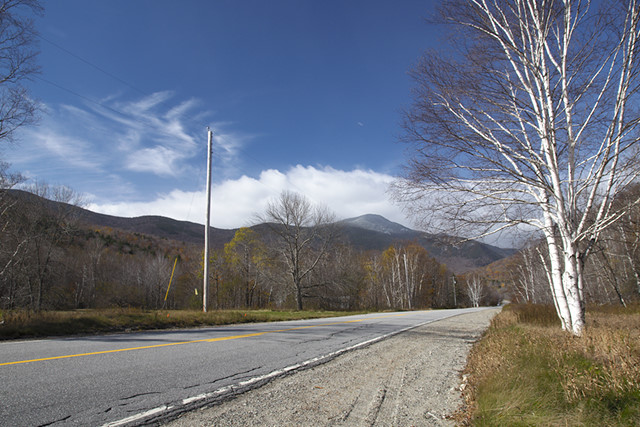
I wasn't the only one in the family who felt this way either. As we hiked out my oldest daughter started to tell me how she thought she might enjoy doing this for a longer duration - like a month or two. Meanwhile my son was completely in his element, hopping merrily down the dangerously icy trail, enjoying every minute of it. My wife, after arriving home and looking at all of her beautiful photos and reflecting on the weekend proclaimed, "I think I am getting addicted to this". My youngest daughter... well her tummy hurt, but she is going through that phase right now.
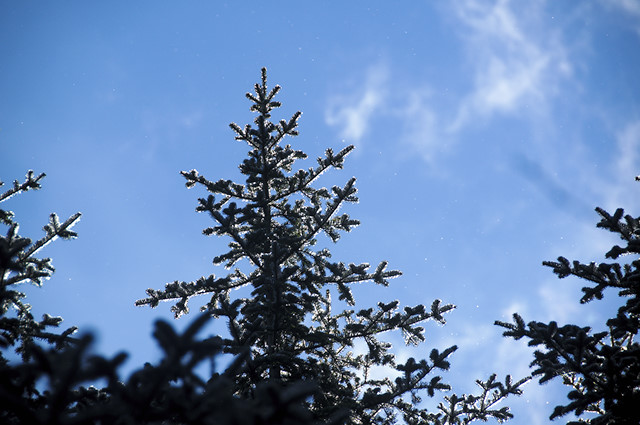
The trip was anything but perfect. We exited a day earlier than planned, and the weather conditions were less than ideal by most backpacker's standards. Maybe we aren't in the category of "most backpackers" anymore. We hiked in freezing temperatures, daytime highs rarely getting above 35F. Our water bottles froze, hands and feet got wet and cold. Trail conditions were at times very steep, very wet, and very icy. Sometimes all at once. Oh, and the wind blew continuously. At night, the temperature dipped to 19F - the coldest we have done as a family - and the wind blew even harder.
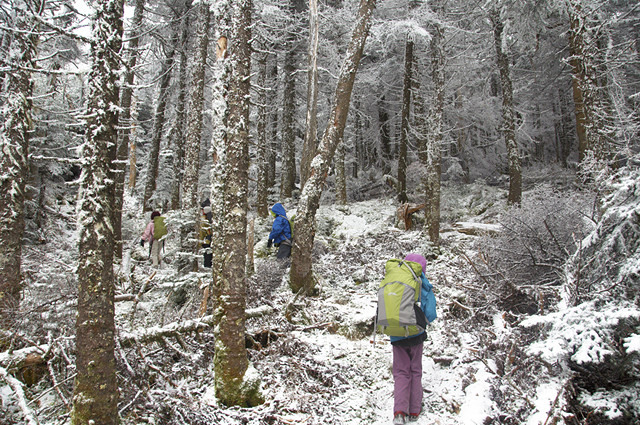
I have wanted to hike the Mahoosuc Notch portion of the AT for some time. Our plan was to backpack into Speck Pond (a short 3.6 mile trek), spend the night, do a hike through the notch the following day (6 - 7 miles), spend the second night back at Speck pond, then hike out on the 3rd day. Since I hadn't taken the family out in shoulder-season conditions before, I didn't want to push too hard on the mileage. This seemed like a pretty easy weekend.
What happened in actuality was that we hiked in the first day, spent the night at Speck pond, then hiked out the next. Our light-weight trail runners were on the edge of being able to handle the icy conditions going in. Since the forecast was predicting that the third day would bring more freezing conditions along with the potential for rain, we decided that it would be safer to hike back out on a nice day rather than contend with trail conditions getting even worse.
Despite the change in plans, there were plenty of new experiences all-around to make the trip fun and successful:
We tested out some new equipment:
- A new, lighter weight tent: a Hilleberg Nallo 4 GT. For those of you who have done the math, it sleeps one less than we have in our family. This means that I had to tarp camp in the vestibule. It actually worked really well. More details will be forthcoming in our future Backpacking Light article on family shelters.
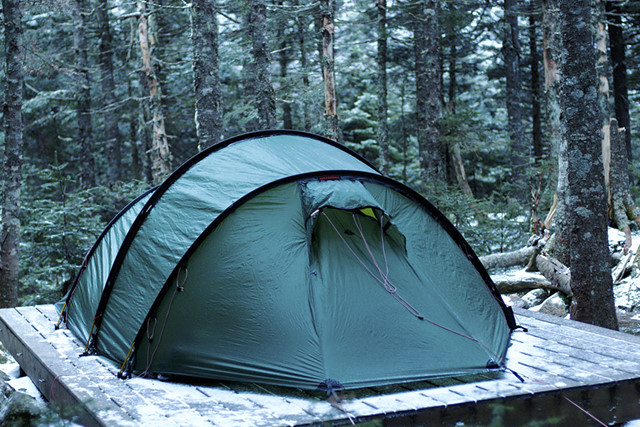
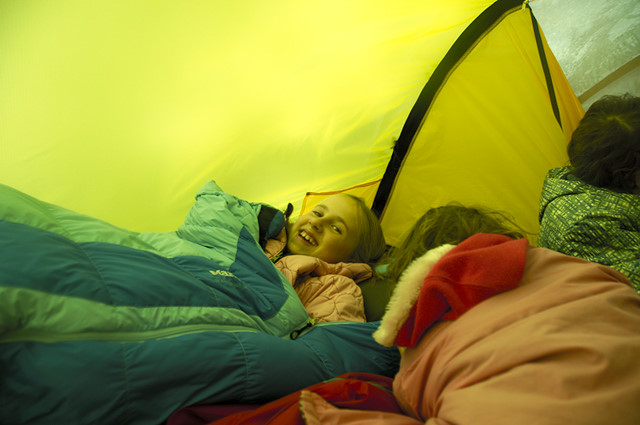
- A new pair of shoes: I wore a pair of Inov-8 X-Talon 190s. I am always on the search for the ultimate in minimalist backpacking footwear. Are these the ones? You will have to wait and read my article at Backpacking Light later this year to find out.
- A new pair of pants: Renee brought her new Mont-Bell Thermawrap pants. If I have learned one thing, it is that the easiest way to keep Renee happy is to keep her warm. These pants were the next logical step for us in rounding out her cold weather gear.
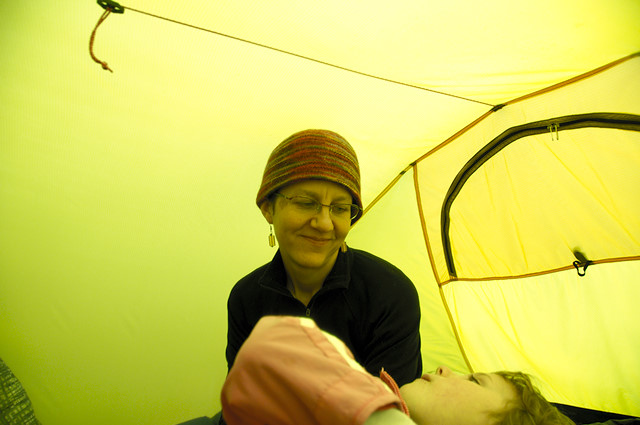
We practiced some new techniques:
- I am becoming more comfortable with using a quilt instead of a sleeping bag. For this trip I used a Backpacking Light UL 240 Quilt, Cocoon hoody and pants with a Katabatic Gear Bristlecone bivy when sleeping in the vestibule. I am happy to report that I was very warm, and am officially sold on quilts. I will be interested to see how low of a temperature this system will be comfortable for me.
- We tried a new strategy for water treatment: Aquamira. In the past we have used a First Need water purifier. Although it was heavy, I justified the weight by the fact that we were a group of 5. In an effort to save weight and simplify life a little, I have been looking for ways to overhaul our water treatment system. After using Aquamira on our Teton trek, I decided to give it a try with the family. So far it has been working great, and has definitely made trail life simpler not to mention lighter as well.
- We have transitioned from planned lunches to small snacks (one of our favorite recipes here). In the past we would plan a lunch meal and then eat it together at some point during the day. This has always been somewhat of a pain for us as not everyone is hungry at the same time, and everyone doesn't always feel like eating the same thing. This trip everyone carried a variety of snacks. People could eat as much as they wanted, whenever they wanted. The kids really liked this arrangement, and it made eating while on the trail a lot simpler.
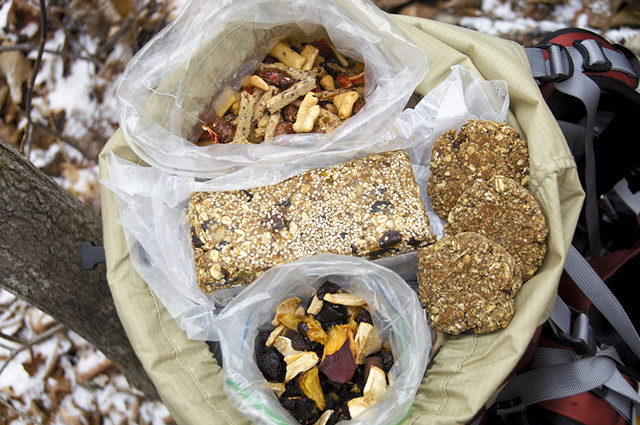
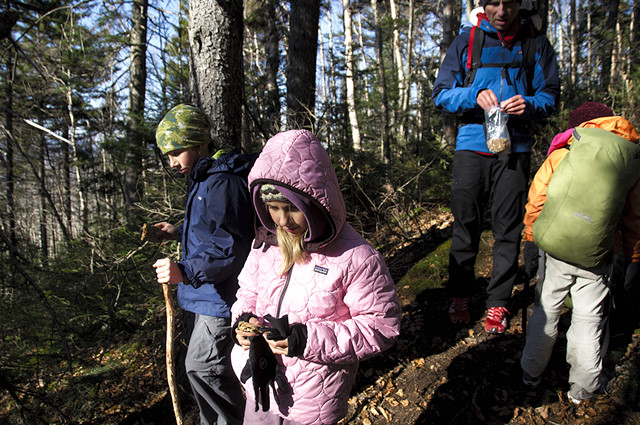
We experienced some new challenges:
- Water bottles froze. What is the best strategy for dealing with freezing water on the trail?
- Our stove - an MSR WindPro operating with as an inverted canister - froze-up on occasion and required twisting the valve a few times to restore flow. What would happen in colder conditions? Is this issue common? Would a different brand/model of canister stove behave better?
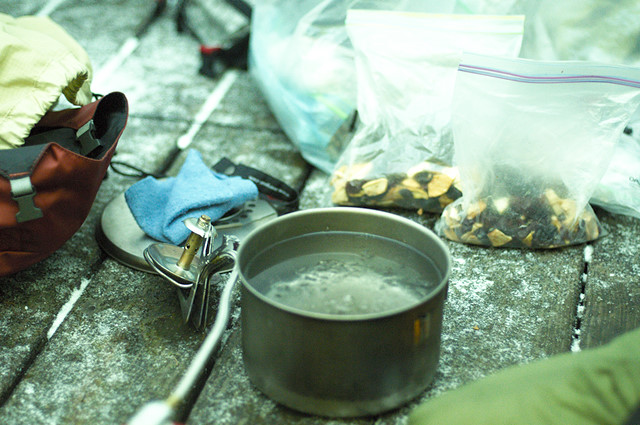
- Dishes didn't get cleaned and our breakfast of chocolate rice pudding tasted a bit like the curry we ate the night before. How do people deal with washing dirty dishes in freezing conditions? Do they heat water up for doing the dishes, or is there another strategy I should know about?
- Condensation and sleep systems. For Renee, she woke up with a layer of moisture across the top of her sleeping bag. For myself, I woke up with a layer of moisture between my quilt and the bivy. Is this a problem? Does this mean we need to start looking into vapor barrier clothing/liners?
- What is the optimal footwear for kids in these conditions? We are still working on this one... lots more experimentation is required. If only money were no object, we could test it more thoroughly.
As far as gear goes, I felt we really had things dialed-in. We had exactly what we needed for the conditions we encountered, it seemed almost perfect.
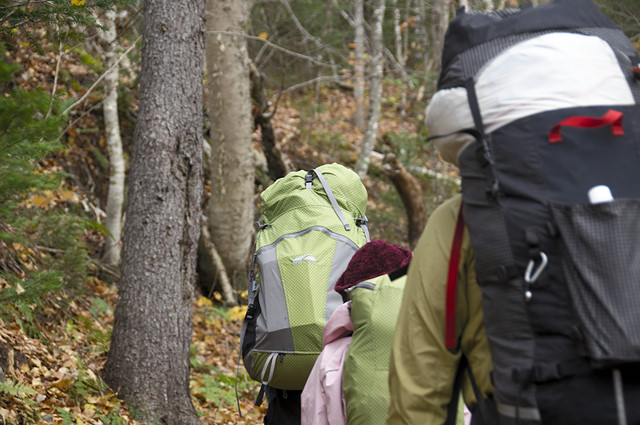
Despite being some of the coldest conditions in which we have backpacked, this has been the lowest pack weights that Renee and I have carried. I can't say the same for the kids though ;-) As they are getting more experienced, we are gradually letting them carry more. This time, in addition to their regular loads, they each carried a portion of the food. I was interested to see how this extra weight would affect them. Carrying a pack is starting to become normal for everyone, to the point now where the kids are not noticing their load so much any more. The extra weight didn't seem to phase them. A big win for the parents!
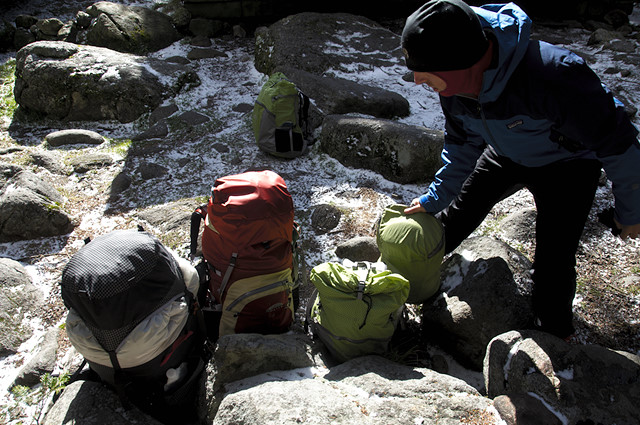
Every time we get out, I try to push our envelope a little further. This can be a difficult thing to gauge as I really never know what to expect. Will the distance be too far? Will the terrain be too difficult? Will the weather be too nasty? So far it has worked out really well for us. Despite some challenges along the way, we always emerge on the other side better for it. Our relationships grow, our experience grows, our confidence grows, our strength grows, our faith grows, and after barely getting into the car to head home, we get even more excited about what the next trip will bring.

Comments
What Works for Us
Snow 'packing is so much fun! It's a totally magical experience for the entire family. My son loves to read books in our tent when it is really cold and play with seeing his breath as I read. Though we are not long distance packing in the snow yet, we do weekend trips throughout the winter and really enjoy the experience. On the 12th we are going to do Mt. Adams! Both Jules and I have long distance packed in the snow, and he was an avid ice climber before The Barracuda.
We are backpacking bums when it comes to certain things. I grew up long distance packing in my father's old military and forest service gear. It was all cotton, most of it smelled funny, and when it rained he would rip a head hole in garbage bags and shove them over my brother and I pack and all. We didn't get arm holes because it was too much of a hassle. Jules had no money when he packed the AT because he was 17, so he bums it too. I know what we do doesn't work for everyone because for most it is just too savage, but it might help until you guys find a better solution (or become savages as well :).
Dishes: We don't use water to wash any of our dishes. We use Dr. Bronner in a 1/2 ounce Nalgene and then wipe it out with either leaves or leaves and grass. They are abrasive enough, readily available, and in our area they are always wet. If it is icy or snowy, the heat from your hands will melt the frozen water and then you don't need added water. It cleans the dishes just fine and they don't taste like residue. The Castile soap is 100 percent non-toxic and as long as you only use one drop (it's extremely concentrated) there is no taste of reside at all. Every 3 days or so we will actually wash the dishes with water, but this is more of a rinsing soak. They are washed when we either bathe or wash our clothes.
Stove: We have an MSR WhisperLite Intl. and also an MSR XGK. They are white gas specifically so we don't have the freezing problem of canisters. If you sleep with the canister in your sleeping bag(so that it stays warm) then the problems tend to be minimized some. Honestly, though canisters are slightly lighter, they are just plain finicky and when long distance packing you can't always get the canisters when you need them. We use the WhisperLite when we are going into cold conditions (10 degrees and above) but aren't going to be dealing with feet of snow. The XGK is like a blowtorch and works better for defrosting snow. We don't really need it, but Jules bought it from a guy quitting the AT for 20 bucks. It can't be adjusted much, but it will heat through the arctic!
Water Bottles: If you put your water bottle into the bottom of your sleeping bag it won't freeze tight. Your body heat will keep it from completely solidifying. This is the easiest way I know of and works most of the time in even below zero conditions. If there are feet of snow around you, invert the water bottles and bury them in the snow. The snow will insulate them and keep them from freezing in most conditions, though not all. Be sure to mark the placement with your hiking poles or you can loose them. The inverting allows the entire bottle to not freeze tight due to the physics of the water molecules. When you open it, you will be able to drink at least a swallow or two and it melts as you pack if you keep it close to you.
Kids Footwear: This is rather ghetto, but I grew up on it and so did Jules so we can guarantee it works. Put on a sock liner, then a plastic bread bag, a wool sock and then the shoe. The bread bag is secured around the calf with a rubber band and it goes under your pants. Gators go on over your pants (my father didn't purchase us Gators, but we wore wool legwarmers over the bread bag and under our pant legs). The bread bag is an instant vapor barrier and also insulates the foot some. Our entire family wears Salomon Clima-Tex boots we got off of Ebay. These would not fall under the minimalist footwear title, but they are bombproof and we never have to worry about delaming, rain, snow, or discomfort. He can carry weight and hike back to back days of 10 miles. We have yet to find anything minimalist which will keep him either warm, dry, or comfortable enough in the wet/snow. Polar fleece pants covered by Seam-sealed gators work pretty darn well for moisture and warmth of his ankles/legs. I don't know if the shoes you are using have gator rings through. The minimalist shoes he uses in the summer don't.
Condensation: We have synthetic bags so we just don't worry about the condensation. Our TarpTent ventilates really well and that helps some too. Jules was a buyer for an outfitter on the AT and worked for years at Neils Gap. When he had seasoned packers come through, many carried a paintbrush and would brush the condensation off the inside of the tent and then out the door. When my family hiked the PCT, we had shifts during the night to wake up and take the condensation off the inside (and snow off the outside) because we were using old military down bags which couldn't get wet. If you put the clothes you want to wear the next morning into the bottom of your bag, they will stay dry and warm for the next day.
I'm with Renee on the cold. I HATE it. I get a bit fussy when I get either wet or cold so I use kayaking river bags for most of my stuff. I also double bag my undies and socks in Ziplocks so I don't have to wear damp ones in the morning. We purchased silicone impregnated nylon to make our stuff sacs and that has helped as well. Ray Jardine sells it by the yard in multiple colors for extremely cheap.
I don't know if any of this is even remotely helpful. Perhaps your questions were rhetorical. But, it has been a great distraction from the work I should be doing :)
Good luck in your future pursuits! Jules is totally jealous of the area you live in. He thinks Speck Pond is beautiful and really wants to do the Long Trail with The Barracuda, but airfare is so cost prohibitive. When we move we will be able to save more and then galavant everywhere. Until then, we get to play around in my old stopping grounds of the Cascades.
Thanks for all of the input,
Thanks for all of the input, lots there for me to digest. The questions were not rhetorical, I am genuinely interested in knowing what everyone else does.
I have purposely avoided using white gas for cold weather use. I feel much safer using canister gas (no flare-up when starting the stove), especially when cooking in the vestibule. Remote canister stoves used with the canister inverted are supposed to function in really cold temperatures (as low as to -22 F). Basically, they behave like a white gas stove, without the side effects of flare-up when starting. I suspect the problems I was seeing were due to the stove design... but I am not certain. In warmer months we like to use alcohol and wood.
I am with you on the footwear system for kids, that is basically what we do. I am trying to decide what I want to use for the shoe/boot this year. Last year I bought the kids some Keen winter boots on Sierra Trading post. They didn't work out so well, they were too heavy and they didn't really keep the kids feet all that warm. This year I am thinking lighter weight footwear with good soles and lots of room for thick socks...
Dishes
Ah, the joy of dishes in the snow.
Like Granola Girl, I generally use a handful of snow to get most of everything out, plus a tiny little plastic scraper. Then I heat a cup of water, add some detergent, and starting with the least greasy plates, work my way through, tipping from dish to dish. I carry a pair of light weight dishwashing gloves to keep my hands dry, which makes it much more pleasant. I use them if I'm digging a snow platform, or pulling down a wet tent too. It means I'm happy to dry the tent off in the morning, since my hands aren't screaming at me.
Did your bottles freeze at night, or while walking? In temps like this, I think Nalgene's are worth the weight. The bigger mouth is less prone to freezing, you can start with hot (to boiling) water, you can use them as a hot water bottle in your sleeping bag at night, which also starts your breakfast with tepid rather than frigid water. You can add rice and chocolate to your hot water bottle at night, and just warm it in the morning. You can use them as a cup, esp if you add a sipping insert. You probably need an insulated parka for them if you want to stop them freezing during the day, unless your jacket has an inside pocket it will fit into.
I also use plastic bags inside the runners for the kids. Carry spares though, and spare dry socks obviously. If you're eating in the tent, feet can go in sleeping bags, but if you're in a snow kitchen, the wet boots can chill the kids feet again, even with dry socks inside the plastic bags. My solution was to put the sleeping bag in a garbage bag, and have the kids stick their socked feet in there.
Looks like a great trip!! I'm keen to see how the Nallo goes/went
Rod
Thanks for the input and the
Thanks for the input and the great suggestions!
The freezing water was mostly a problem while on the trail. In the tent we were able to keep it warm enough through the night. Interesting idea on re-hydrating your breakfast food through the night, I might have to try that one out some time.
I think a plastic scraper and gloves sound like a good ideas, that would have been handy to have on this trip.
Freezing Water Bottles
I took a winter backpacking course and the instructors had us all make insulated tubes for our waterbottles. I don't have a picture, so it's kind of hard to explain, but here goes.
We used 1/2-inch-thick dense foam (similar to those ubiquitous blue foam sleeping pads, but not quite as rigid). Cut a piece of foam wide enough to wrap around your water bottle and tall enough to extend beyond the top and bottom of your bottle about an inch. Duct tape the two edges to form a tube. Then cut a circular piece to fit in one end of the tube and tape it on (don't be minimalist with the duct tape!). If desired, you can also cut another circular piece as a lid for the top and make a duct tape "hinge". This insulation was enough to keep our water bottles from freezing solid in -15 or -20C conditions. (The water was still REALLY COLD with some ice formation around the edges, but still drinkable). At night we put them in our sleeping bags.
Hopefully the place you usually keep your bottles in/on your packs will accomodate the extra thickness of the foam tube. Some people in my course opted to cut two vertical slits on one side of the tube big enough for the backpack's hip belt to slide through - then you can wear the tube on your hip like a holster so your water is more accessible. (Make sure you reinforce the slits with plenty of duct tape). But not everyone likes having stuff attached to their belts when hiking.
Cheers,
MJP
Great ideas. I think that
Great ideas. I think that insulating our water bottles is something that we will have to do for our next trip. Since we use Playpus bottles right now, I may have to find an insulation that is flatter.
Footwear
In terms of minimalist winter footwear, I am very excited to try these boots from Soft Star: http://www.softstarshoes.com/index.cfm?fuseaction=product.display&Produc...
I'm not sure about how they will be in really wet conditions (it says they're great in slush, but they're leather, so...?) but I am really hoping they deliver on the WARMTH while still being lightweight.
I've also ordered the child version for my toddler - I'll try to remember to let you know how they are once they arrive. They're pricey, but if they work, I think it's worth it to have warm dry feet!
MJP
I would be very interested in
I would be very interested in knowing how those work out for your child! Let me know once you have had some time to try them.
Water - If you're talking at
Water - If you're talking at night, I used to heat up water at night, fill the bottle, wrap it in a spare sock, and toss it down by my feet for the night. No freezing bottle and toasty toes as you drift off to sleep. During the day, I made some bottle cozies from an old closed cell sleeping pad, then put the bottle in the pack upside down, so that if ice does form, it isn't at the opening.
Dishes - Pre-family, I would have wiped it out with hot water and a rag if it was really gross, then boiled up some water in the pot for some evening tea as a final step. Now, I actually wash stuff.
Stove - that is exactly the issue with canister stoves and why I've always liked white gas/multi fuel stoves. Right now I have a 15+ year old MSR XGK, my brother is still using his coleman peak 1 from 25 years ago. I've not seen anything I like better in cold weather.
Moisture - I try to fluff out my sleeping bag in the sun as I'm breaking camp in the morning to allow moisture to evaporate / sublimate and that helps. I always found VBLs to be uncomfortable. I only used them on extended trips in very cold weather. Otherwise, I'd rather pack some extra socks. I also would sleep with the next days' clothes in my bag along with boot liners. The moisture you were seeing may not even be a significant problem. I never saw it as an issue on trips up to a week or so. Longer than that, we would take a rest day to air stuff out in the sun. The worst I ever dealt with was a stretch of freezing rain in the Adirondacks. We ended up stretching the tent fly across the front of a lean-to and cranking the stoves to heat it up and help dry some stuff.
I look forward to mine getting a bit older so I can have these same problems with my family :)
Thanks Jason. Sleeping pad
Thanks Jason.
Sleeping pad foam sounds like a good idea for making a cozy for water bottles.
I wasn't sure that the moisture on the bags was really a problem either. I don't think we really lost any loft, but was just kind of a new thing for us to experience.
Love reading this post and
Love reading this post and thinking about backpacking with my boys. They are still little (2 and 3 years), so we just day hike. This weekend my 3 year old hiked 5 miles and I was pscyched for him. I just carry the other one, which makes backpacking a little much. Next summer, my (then) 4-year-old and I are taking his first backpacking trip. I guess I'll carry just about everything, but it will be worth it.
5 miles, wow, that is great!
5 miles, wow, that is great! Day hiking is all we did for the first couple of years. We got the kids used to doing the hikes and practiced our gear skills while car camping before we started backpacking.
light shoes for snow
Interested to see what you come up with for shoes going into winter. I'm intrigued by the minimalist idea, but our lifestyle here doesn't make it easy (walking on rough gravel roads, slippery trails, prickly brush, snow, slush, ice, etc...). I don't find normal shoes all that durable, and rubber boots are the most common footgear here. We've had good luck for the toddler just making homemade boots that are basically like neoprene socks. But that won't hold up for an adult!
What do you and Hig normally
What do you and Hig normally use for your footwear? What have you found is durable enough for the conditions you guys are in?
Wow, this fills me with so
Wow, this fills me with so much joy - adore your blog, been lurking here for some time and just wanted to let you know that your 'one day a week' manifesto really touched me; my partner and I are both Scout leaders (no little ones of our own yet) so we adapted your idea to 'one weekend a month' and have been taking the boys camping or hiking once a month ever since. In sun, rain, gales, snow, more rain....
The progress they've made in being able to independently (they're 10 -14yrs old) kit themselves out, navigate, pitch camp, prepare meals etc. has been astonishing. And the relationships forged have been pure magic. For Tom and I this time together investing so much in this group of boys has really strengthened our relationship and is something we will definitely aim to continue with our own family, whenever that might be.
May God bless all your adventures.
one weekend a month
Mave, thanks so much for your comment. It means a lot to us. Our family has a one weekend a month trip goal. Sometimes that goal is interrupted but other plans, like Damien's trek in the Tetons in September and my trip to see my folks.
The challenge will be winter. We are set for the end of November. And we have a cabin picked out for January. Still have to find another cabin or two for Feb & March. April should be warm enough to tent again as we did this year.
Couldn't agree more about how this time outdoors together strengthens our relationships. That's one of the key pieces to the whole idea. That and enjoying the beauty of creation.
Pingback
[...] Looking Back on Speck Pond (October 2010) [...]